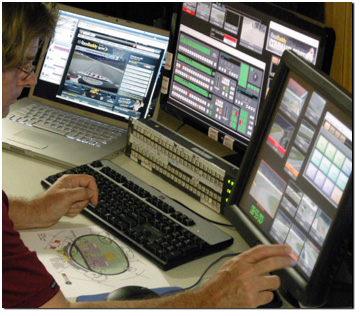Entertainment Technology News
| Turner Studios Uses Broadcast Pix Slate 3000 to Create 'Second Screen' Experience for NBA and NASCAR Telecasts By Staff posted Nov 23, 2009, 11:24 |
Fluent Workflow Software Enables Cost-Effective, Streamlined Production for Webcasts

(Billerica, Massachusetts) Broadcast Pix� announces that Turner Studios, a division
of Turner Broadcasting System, Inc. in Atlanta, Ga., is using the Broadcast
Pix Slate� 3000 integrated production system with Fluent� workflow tools to
produce an innovative "second screen" experience for sports fans.
Accessible via Web or mobile devices, live webcasts complement Turner Sports'
live NBA basketball and NASCAR coverage on TNT. While watching the live event,
viewers can log on to "TNT Overtime" on NBA.com or TNT.tv, or "TNT RaceBuddy"
on NASCAR.com or TNT.tv, and see additional HD camera views of the live action,
as well as timely scores, stats, and exclusive interviews. The Slate 3000 is
located within the broadcast TV compound, and its integrated router receives
feeds from all of Turner Sports' HD broadcast cameras covering the live event,
as well as unique, dedicated cameras and coverage exclusively for broadband.
"The Slate 3000 is a great solution for 'TNT Overtime' and 'TNT RaceBuddy' because
it lets a single operator control all aspects of the webcasts, as well as up
to five simultaneously streamed outputs, all from a single, compact system,"
said Bill Chapman, vice president of creative development/emerging technologies
for Turner Studios.
Using the system's SoftPanel and custom programmed macros, part of the Fluent
Team Control toolset that allows access and control via a Flash-based user interface
and Web browser on a PC or Mac, Chapman can work from any location. "Rather
than having to resort to a conventional HD production switcher and control room,
which would add considerably to the cost and complexity of this cutting-edge
Web application, I can direct these multi-camera shows from a touch screen interface,
or on my laptop, from virtually any remote location," he added. "If I decide
to work from a remote location, like my office, the network connection to the
Slate doesn't need to be robust because I'm only sending the commands, not a
heavy HD video load."
Two of the four on-screen windows on "TNT Overtime" feature cameras following
specific players, while one of the "TNT RaceBuddy" windows is a viewer-selected
in-car camera. Featured NBA players can change every quarter, while NASCAR drivers
can change every 50 laps. The online audience decides which players and drivers
they want to see by voting on the "TNT Overtime" and "TNT RaceBuddy" sites.
The other windows showcase different camera perspectives of the basketball court
or racetrack, including unique commentary from courtside or Pit Lane.
"The Slate doesn't just remember switcher moves, it recalls all of the set-ups
you've customized for the needs of a particular production, including multi-view
monitoring, router inputs/outputs, and camera and playout settings," said Chapman.
"One person can do the work of three people, serving as the technical director,
graphics, and video operators - and one system provides a great array of HD
resources. Without Slate, our multi-screen Webcasts wouldn't be as flexible
or creative."
Over six NASCAR races this year, "TNT RaceBuddy" drew an average of 492,000
unique visitors per race and delivered a total of 2.4 million live streams.
Also, during Game 5 of the 2008/2009 NBA Playoffs, "TNT Overtime" delivered
768,143 streams and 78,565 "uniques;" while Game 4 delivered more than 700,000
streams. Because of their interactive nature, the sites offer an effective platform
for advertisers to reach their prime targets.
"I'm able to import all the integrated ads, graphics, and other media content
for the show from the Internet right into the Slate's still and clips stores
at game time, and then manage them from within the system," Chapman explained.
"I can switch all the cameras for this multi-screen presentation with a simple
touch screen, as well as create the lower third supers and transitional graphics
and roll them in at the appropriate times."
Resources:
Broadcast Pix: www.broadcastpix.com